
The Nez Perce are an Indigenous people of the Plateau who still live on a fraction of the lands on the southeastern Columbia River Plateau in the Pacific Northwest. This region has been occupied for at least 11,500 years.
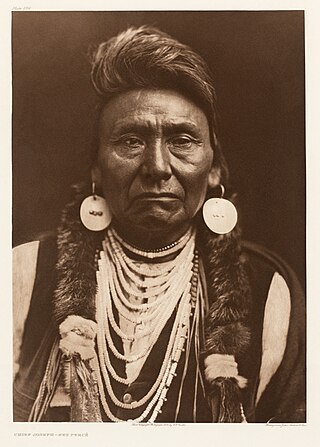
Hin-mah-too-yah-lat-kekt, popularly known as Chief Joseph, Young Joseph, or Joseph the Younger, was a leader of the wal-lam-wat-kain (Wallowa) band of Nez Perce, a Native American tribe of the interior Pacific Northwest region of the United States, in the latter half of the 19th century. He succeeded his father tuekakas in the early 1870s.

The Nez Perce War was an armed conflict in 1877 in the Western United States that pitted several bands of the Nez Perce tribe of Native Americans and their allies, a small band of the Palouse tribe led by Red Echo (Hahtalekin) and Bald Head, against the United States Army. Fought between June and October, the conflict stemmed from the refusal of several bands of the Nez Perce, dubbed "non-treaty Indians," to give up their ancestral lands in the Pacific Northwest and move to an Indian reservation in Idaho Territory. This forced removal was in violation of the 1855 Treaty of Walla Walla, which granted the tribe 7.5 million acres of their ancestral lands and the right to hunt and fish on lands ceded to the U.S. government.

The Nez Perce National Historical Park is a United States National Historical Park comprising 38 sites located across the states of Idaho, Montana, Oregon, and Washington, which include traditional aboriginal lands of the Nez Perce people. The sites are strongly associated with the resistance of Chief Joseph and his band, who in June 1877 migrated from Oregon in an attempt to reach freedom in Canada and avoid being forced on to a reservation. They were pursued by U.S. Army cavalry forces and fought numerous skirmishes against them during the so-called Nez Perce War, which eventually ended with Chief Joseph's surrender in the Montana Territory.

The Battle of the Big Hole was fought in Montana Territory, August 9–10, 1877, between the United States Army and the Nez Perce tribe of Native Americans during the Nez Perce War. Both sides suffered heavy casualties. The Nez Perce withdrew in good order from the battlefield and continued their long fighting retreat that would result in their attempt to reach Canada and asylum.
The Battle of the Clearwater was a battle in the Idaho Territory between the Nez Perce under Chief Joseph and the United States Army. Under General O. O. Howard, the army surprised a Nez Perce village; the Nez Perce counter-attacked and inflicted significant casualties on the soldiers, but were forced to abandon the village.

The Battle of Bear Paw was the final engagement of the Nez Perce War of 1877. Following a 1,200-mile (1,900 km) running fight from north central Idaho Territory over the previous four months, the U.S. Army managed to corner most of the Nez Perce led by Chief Joseph in early October 1877 in northern Montana Territory, just 42 miles (68 km) south of the border with Canada, where the Nez Perce intended to seek refuge from persecution by the U.S. government.

The Battle of Camas Creek, August 20, 1877, was a raid by the Nez Perce people on a United States Army encampment in Idaho Territory and a subsequent battle during the Nez Perce War. The Nez Perce defeated three companies of U.S. cavalry and continued their fighting retreat to escape the army.

The Nez Perce (Nee-Me-Poo) National Historic Trail follows the route taken by a large group of the Nez Perce tribe in 1877 to avoid being forced onto a reservation. The 1,170-mile (1,883 km) trail was created in 1986 as part of the National Trails System Act and is managed by the U.S. Forest Service. The trail traverses through portions of the U.S. states of Oregon, Idaho, Wyoming, and Montana and connects sites across these states that commemorate significant events of the Nez Perce War that took place between June and October 1877, as several bands of the Nez Perce tried to escape capture by the U.S. Cavalry. The sites are among the 38 that are part of the National Park service's Nez Perce National Historical Park, managed over all by the National Park Service, with some sites managed by local and state affiliated organizations.
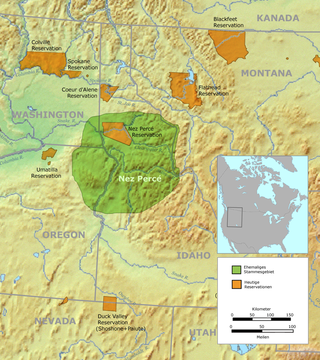
The Battle of White Bird Canyon was fought on June 17, 1877, in Idaho Territory. White Bird Canyon was the opening battle of the Nez Perce War between the Nez Perce Indians and the United States. The battle was a significant defeat of the U.S. Army. It took place in the western part of present-day Idaho County, southwest of the city of Grangeville.
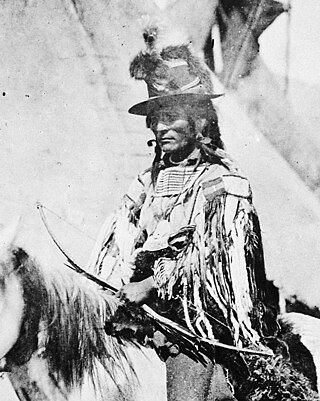
Looking Glass was a principal Nez Perce architect of many of the military strategies employed by the Nez Perce during the Nez Perce War of 1877. He, along with Chief Joseph, directed the 1877 retreat from eastern Oregon into Montana and onward toward the Canada–US border during the Nez Perce War. He led the Alpowai band of the Nez Perce, which included the communities of Asotin, Alpowa, and Sapachesap along the Clearwater River in Idaho. He inherited his name from his father, the prominent Nez Percé chief Apash Wyakaikt or Ippakness Wayhayken and was therefore called by the whites Looking Glass.

White Bird, also referred to as White Pelican, was leader, war chief and tooat of the Lamátta or Lamtáama band of the Nez Perce tribe with the Lamata village along the Salmon River. His band and the village took its name from Lahmatta, by which White Bird Canyon was known to the Nez Perce.
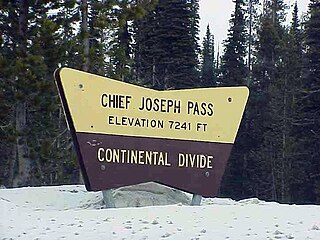
Chief Joseph Pass is a mountain pass on the continental divide of the Rocky Mountains in the northwestern United States joining Lemhi County, Idaho, and Beaverhead County, Montana. The pass is in the Bitterroot Mountains and is traversed by Montana Highway 43; it is named after Chief Joseph of the Wallowa band of the Nez Perce tribe, who traversed the pass in the summer of 1877 during the Nez Perce War, prior to the Battle of the Big Hole to the east.

The Old Chief Joseph Gravesite, also known as Nez Perce Traditional Site, Wallowa Lake, Chief Joseph Cemetery and Joseph National Indian Cemetery is a Native American cemetery near Joseph, Oregon. The area was also a traditional campsite of the Nez Perce and may be archaeologically significant. It was declared a National Historic Landmark in 1985, listed as Wallowa Lake Site. It is a component of the Nez Perce National Historical Park.

The Battle of Canyon Creek was a military engagement in Montana Territory between the Nez Perce Indians and the United States Army's 7th Cavalry. The battle was part of the larger Indian Wars of the latter 19th century and the immediate Nez Perce War. It took place on September 13, 1877, west of present-day Billings in Yellowstone County, in the canyons and benches around Canyon Creek.
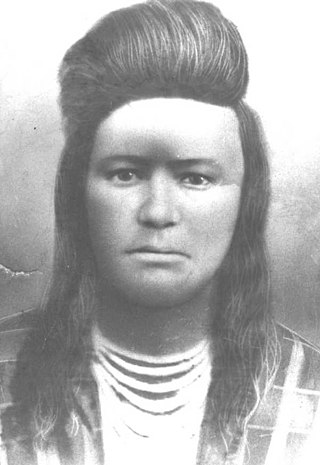
Ollokot, was a war leader of the Wallowa band of Nez Perce Indians and a leader of the young warriors in the Nez Perce War in 1877.
Fort Fizzle was a temporary military barricade in the western United States, erected by the U.S. Army in July 1877 in Montana Territory. Its purpose was to intercept the Nez Perce in their flight from north central Idaho Territory over Lolo Pass into the Bitterroot Valley of western Montana. The name describes the effectiveness of the fort.

The Nez Perce native Americans fled through Yellowstone National Park between August 20 and Sept 7, during the Nez Perce War in 1877. As the U.S. army pursued the Nez Perce through the park, a number of hostile and sometimes deadly encounters between park visitors and the Indians occurred. Eventually, the army's pursuit forced the Nez Perce off the Yellowstone plateau and into forces arrayed to capture or destroy them when they emerged from the mountains of Yellowstone onto the valley of Clark's Fork of the Yellowstone River.
Most popularly known for his contribution to the Nez Perce people during the Nez Perce War of 1877, Poker Joe went by several monikers to include Little Tobacco, Hototo, and Nez Perces Joe. Half French Canadian and half Nez Perce, his birth name was Joe Hale, and his tribal name was Lean Elk. Joe Hale gained the nickname Poker Joe through his obsession with gambling and poker.
The Chief Joseph Trail Ride is an annual horse trail ride that follows the route the Nimiipuu took during the Nez Perce War in 1877. The trail in its entirety is 1,300 miles long, separated into thirteen separate rides, which take place sequentially. The ride is on a 13-year cycle. The trail ride was started in 1965 by the Appaloosa Horse Club.















